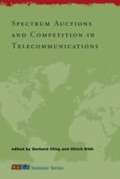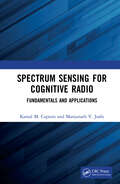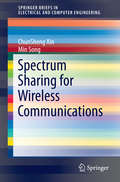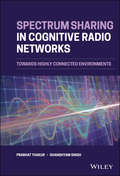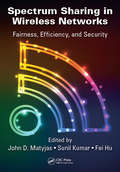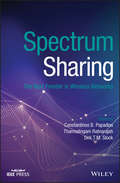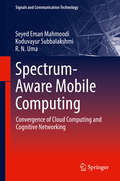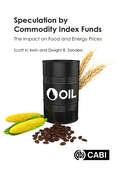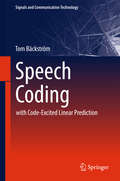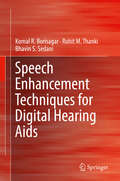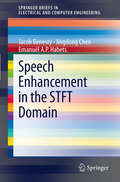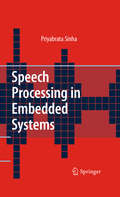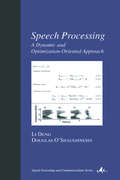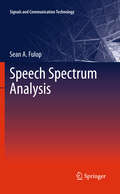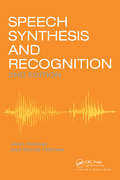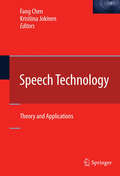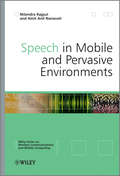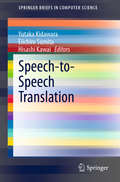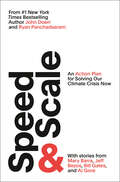- Table View
- List View
Spectrum Auctions and Competition in Telecommunications
by Gerhard Illing Ulrich KlühThis book collects essays on this topic by leading analysts of telecommunications and the European auction experience, all but one presented at a November 2001 CESifo conference; comments and responses are included as well, to preserve some of the controversy .
Spectrum Management
by William Webb Cave, Martin and Webb, William Martin CaveAre you fully up-to-speed on today's modern spectrum management tools? As regulators move away from traditional spectrum management methods, introduce spectrum trading and consider opening up more spectrum to commons, do you understand the implications of these developments for your own networks? This 2007 book was the first to describe and evaluate modern spectrum management tools. Expert authors offer insights into the technical, economic and management issues involved. Auctions, administrative pricing, trading, property rights and spectrum commons are all explained. A series of real-world case studies from around the world is used to highlight the strengths and weaknesses of the various approaches adopted by different regulators, and valuable lessons are drawn from these. This concise and authoritative resource is a must-have for telecom regulators, network planners, designers and technical managers at mobile and fixed operators and broadcasters, and academics involved in the technology and economics of radio spectrum.
Spectrum Sensing for Cognitive Radio: Fundamentals and Applications
by Kamal M. Captain Manjunath V. JoshiThis comprehensive reference text discusses concepts of cognitive radio and the advances in the field of spectrum sensing. This text discusses the concept of cognitive radio for next generation wireless communication and a very critical aspect of cognitive radio – that is, spectrum sensing – in detail. It covers important topics including narrowband spectrum sensing, wideband spectrum sensing, cooperative spectrum sensing, system and channel models, detection algorithms, approximation of decision statistics, and theoretical analysis of detection algorithms in detail. Separate chapters are dedicated to discussing the analysis and use of detection algorithms for narrowband spectrum sensing, wideband spectrum sensing, and cooperative wideband spectrum sensing. Aimed at graduate students and academic researchers in the fields of electrical engineering and electronics and communication engineering, this text: Discusses concepts of cognitive radio and research in spectrum sensing. Presents mathematical analysis of algorithms considering practical environment. Explains novel wideband spectrum sensing algorithms with detailed analysis. Provides mathematical derivations to help readers. Discusses basic spectrum sensing algorithms, from narrowband spectrum sensing to the more advanced wideband spectrum sensing.
Spectrum Sharing for Wireless Communications
by Min Song Chunsheng XinThis SpringerBrief presents intelligent spectrum sharing technologies for future wireless communication systems. It explains the widely used opportunistic spectrum access and TV white space sharing, which has been approved by the FCC. Four new technologies to significantly increase the efficiency of spectrum sharing are also introduced. The four technologies presented are Dynamic Spectrum Co-Access, Incentivized Cooperative Spectrum Sharing, On-Demand Spectrum Sharing and Licensed Shared Spectrum Access. These technologies shed light on future wireless communication systems and pave the way for innovative spectrum sharing with increased spectrum utilization. Increased utilization will allow networks to meet the demand for radio spectrum and promote the growth of wireless industry and national economy. Spectrum Sharing is a valuable resource for researchers and professionals working in wireless communications. Advanced-level students in electrical engineering and computer science will also find this content helpful as a study guide.
Spectrum Sharing in Cognitive Radio Networks: Towards Highly Connected Environments
by Ghanshyam Singh Prabhat ThakurSPECTRUM SHARING IN COGNITIVE RADIO NETWORKS Discover the latest advances in spectrum sharing in wireless networks from two internationally recognized experts in the fieldSpectrum Sharing in Cognitive Radio Networks: Towards Highly Connected Environments delivers an in-depth and insightful examination of hybrid spectrum access techniques with advanced frame structures designed for efficient spectrum utilization. The accomplished authors present the energy and spectrum efficient frameworks used in high-demand distributed architectures by relying on the self-scheduled medium access control (SMC-MAC) protocol in cognitive radio networks.The book begins with an exploration of the fundamentals of recent advances in spectrum sharing techniques before moving onto advanced frame structures with spectrum accessing approaches and the role of spectrum prediction and spectrum monitoring to eliminate interference. The authors also cover spectrum mobility, interference, and spectrum management for connected environments in substantial detail.Spectrum Sharing in Cognitive Radio Networks: Towards Highly Connected Environments offers readers a recent and rational theoretical mathematical model of spectrum sharing strategies that can be used for practical simulation of future generation wireless communication technologies. It also highlights ongoing trends, revealing fresh research outcomes that will be of interest to active researchers in the area. Readers will also benefit from:An inclusive study of connected environments, 3GPP Releases, and the evolution of wireless communication generations with a discussion of advanced frame structures and access strategies in cognitive radio networksA treatment of cognitive radio networks using spectrum prediction and monitoring techniquesAn analysis of the effects of imperfect spectrum monitoring on cognitive radio networksAn exploration of spectrum mobility in cognitive radio networks using spectrum prediction and monitoring techniquesAn examination of MIMO-based CR-NOMA communication systems for spectral and interference efficient designsPerfect for senior undergraduate and graduate students in Electrical and Electronics Communication Engineering programs, Spectrum Sharing in Cognitive Radio Networks: Towards Highly Connected Environments will also earn a place in the libraries of professional engineers and researchers working in the field, whether in private industry, government, or academia.
Spectrum Sharing in Wireless Networks: Fairness, Efficiency, and Security
by John D. Matyjas, Sunil Kumar and Fei HuSpectrum Sharing in Wireless Networks: Fairness, Efficiency, and Security provides a broad overview of wireless network spectrum sharing in seven distinct sections: The first section examines the big picture and basic principles, explaining the concepts of spectrum sharing, hardware/software function requirements for efficient sharing, and future trends of sharing strategies. The second section contains more than 10 chapters that discuss differing approaches to efficient spectrum sharing. The authors introduce a new coexistence and sharing scheme for multi-hop networks, describe the space-time sharing concept, introduce LTE-U, and examine sharing in broadcast and unicast environments. They then talk about different cooperation strategies to achieve mutual benefits for primary users (PU) and secondary users (SU), discuss protocols in a spectrum sharing context, and provide different game theory models between PUs and SUs. The third section explains how to model the interactions of PUs and SUs, using an efficient calculation method to determine spectrum availability. Additionally, this section explains how to use scheduling models to achieve efficient SU traffic delivery. The subject of the fourth section is MIMO-oriented design. It focuses on how directional antennas and MIMO antennas greatly enhance wireless network performance. The authors include a few chapters on capacity/rate calculations as well as beamforming issues under MIMO antennas. Power control is covered in the fifth section which also describes the interference-aware power allocation schemes among cognitive radio users and the power control schemes in cognitive radios. The sixth section provides a comprehensive look at security issues, including different types of spectrum sharing attacks and threats as well as corresponding countermeasure schemes. The seventh and final section covers issues pertaining to military applications and examines how the military task protects its data flows when sharing the spectrum with civilian applications.
Spectrum Sharing: The Next Frontier in Wireless Networks (Wiley - IEEE)
by Constantinos B. Papadias Tharmalingam Ratnarajah Dirk T.M. SlockCombines the latest trends in spectrum sharing, both from a research and a standards/regulation/experimental standpoint Written by noted professionals from academia, industry, and research labs, this unique book provides a comprehensive treatment of the principles and architectures for spectrum sharing in order to help with the existing and future spectrum crunch issues. It presents readers with the most current standardization trends, including CEPT / CEE, eLSA, CBRS, MulteFire, LTE-Unlicensed (LTE-U), LTE WLAN integration with Internet Protocol security tunnel (LWIP), and LTE/Wi-Fi aggregation (LWA), and offers substantial trials and experimental results, as well as system-level performance evaluation results. The book also includes a chapter focusing on spectrum policy reinforcement and another on the economics of spectrum sharing. Beginning with the historic form of cognitive radio, Spectrum Sharing: The Next Frontier in Wireless Networks continues with current standardized forms of spectrum sharing, and reviews all of the technical ingredients that may arise in spectrum sharing approaches. It also looks at policy and implementation aspects and ponders the future of the field. White spaces and data base-assisted spectrum sharing are discussed, as well as the licensed shared access approach and cooperative communication techniques. The book also covers reciprocity-based beam forming techniques for spectrum sharing in MIMO networks; resource allocation for shared spectrum networks; large scale wireless spectrum monitoring; and much more. Contains all the latest standardization trends, such as CEPT / ECC, eLSA, CBRS, MulteFire, LTE-Unlicensed (LTE-U), LTE WLAN integration with Internet Protocol security tunnel (LWIP) and LTE/Wi-Fi aggregation (LWA) Presents a number of emerging technologies for future spectrum sharing (collaborative sensing, cooperative communication, reciprocity-based beamforming, etc.), as well as novel spectrum sharing paradigms (e.g. in full duplex and radar systems) Includes substantial trials and experimental results, as well as system-level performance evaluation results Contains a dedicated chapter on spectrum policy reinforcement and one on the economics of spectrum sharing Edited by experts in the field, and featuring contributions by respected professionals in the field world wide Spectrum Sharing: The Next Frontier in Wireless Networks is highly recommended for graduate students and researchers working in the areas of wireless communications and signal processing engineering. It would also benefit radio communications engineers and practitioners.
Spectrum-Aware Mobile Computing: Convergence of Cloud Computing and Cognitive Networking (Signals and Communication Technology)
by R. N. Uma Seyed Eman Mahmoodi Koduvayur SubbalakshmiThis book presents solutions to the problems arising in two trends in mobile computing and their intersection: increased mobile traffic driven mainly by sophisticated smart phone applications; and the issue of user demand for lighter phones, which cause more battery power constrained handhelds to offload computations to resource intensive clouds (the second trend exacerbating the bandwidth crunch often experienced over wireless networks). The authors posit a new solution called spectrum aware cognitive mobile computing, which uses dynamic spectrum access and management concepts from wireless networking to offer overall optimized computation offloading and scheduling solutions that achieve optimal trade-offs between the mobile device and wireless resources. They show how in order to allow these competing goals to meet in the middle, and to meet the promise of 5G mobile computing, it is essential to consider mobile offloading holistically, from end to end and use the power of multi-radio access technologies that have been recently developed. Technologies covered in this book have applications to mobile computing, edge computing, fog computing, vehicular communications, mobile healthcare, mobile application developments such as augmented reality, and virtual reality.
Speculation by Commodity Index Funds: The Impact on Food and Energy Prices
by Professor Scott H. Irwin Professor Dwight R. SandersCommodity futures prices exploded in 2007-2008 and concerns about a new type of speculative participant in commodity futures markets began to emerge. The main argument was that unprecedented buying pressure from new "commodity index" investors created massive bubbles that resulted in prices substantially exceeding fundamental value. At the time, it was not uncommon to link concerns about speculation and high prices to world hunger, food crises, and civil unrest. Naturally, this outcry resulted in numerous regulatory proposals to restrict speculation in commodity futures markets. At the core, these assertions raised major economic questions about the efficiency of price discovery in commodity futures markets. Moreover, these so-called remedies did not come without a potential cost. Burdensome regulations would increase compliance and risk sharing costs across the global food system, lowering prices for producers and increasing costs to consumers. This book presents important research on the impact of index investment on commodity futures prices that the authors conducted over the last fifteen years. The eleven articles presented in the book follow the timeline of our involvement in the world-wide debate about index funds as it evolved after 2007. We also include an introductory chapter, new author forewords for each article chapter, and a lessons learned chapter to round out the book. Policy-makers, researchers, and market participants will find the book not only functions as useful documentation of the debate; but, also as a natural starting point when high commodity prices inevitably create the next speculation backlash.
Speech Acoustic Analysis
by Philippe MartinThe text sets out in simple and accessible terms the various methods of acoustic analysis of speech, placing them in their historical context, allowing a better understanding of the mathematical and technical solutions adopted today in phonetics and experimental phonology. Without mathematical complications, the operating bases of the many speech analysis software currently available are exposed so that everyone can understand the limits and avoid errors and misinterpretations in their implementation.
Speech Coding
by Tom BäckströmThis book provides scientific understanding of the most central techniques used in speech coding both for advanced students as well as professionals with a background in speech audio and or digital signal processing. It provides a clear connection between the Why’s?, How’s?, and What’s, such that the necessity, purpose and solutions provided by tools should be always within sight, as well as their strengths and weaknesses in each respect. Equivalently, this book sheds light on the following perspectives for each technology presented: Objective: What do we want to achieve and especially why is this goal important? Resource / Information: What information is available and how can it be useful? Resource / Platform: What kind of platforms are we working with and what are the capabilities/restrictions of those platforms? This includes properties such as computational, memory, acoustic and transmission capacity of devices used. Solutions: Which solutions have been proposed and how can they be used to reach the stated goals? Strengths and weaknesses: In which ways do the solutions fulfill the objectives and where are they insufficient? Are resources used efficiently? This book concentrates solely on code excited linear prediction and its derivatives since mainstream speech codecs are based on linear prediction It also concentrates exclusively on time domain techniques because frequency domain tools are to a large extent common with audio codecs.
Speech Enhancement Techniques for Digital Hearing Aids
by Rohit M. Thanki Komal R. Borisagar Bhavin S. SedaniThis book provides various speech enhancement algorithms for digital hearing aids. It covers information on noise signals extracted from silences of speech signal. The description of the algorithm used for this purpose is also provided. Different types of adaptive filters such as Least Mean Squares (LMS), Normalized LMS (NLMS) and Recursive Lease Squares (RLS) are described for noise reduction in the speech signals. Different types of noises are taken to generate noisy speech signals, and therefore information on various noises signals is provided. The comparative performance of various adaptive filters for noise reduction in speech signals is also described. In addition, the book provides a speech enhancement technique using adaptive filtering and necessary frequency strength enhancement using wavelet transform as per the requirement of audiogram for digital hearing aids.Presents speech enhancement techniques for improving performance of digital hearing aids;Covers various types of adaptive filters and their advantages and limitations;Provides a hybrid speech enhancement technique using wavelet transform and adaptive filters.
Speech Enhancement in the STFT Domain
by Jacob Benesty Jingdong Chen Emanuël A.P. HabetsThis work addresses this problem in the short-time Fourier transform (STFT) domain. We divide the general problem into five basic categories depending on the number of microphones being used and whether the interframe or interband correlation is considered. The first category deals with the single-channel problem where STFT coefficients at different frames and frequency bands are assumed to be independent. In this case, the noise reduction filter in each frequency band is basically a real gain. Since a gain does not improve the signal-to-noise ratio (SNR) for any given subband and frame, the noise reduction is basically achieved by liftering the subbands and frames that are less noisy while weighing down on those that are more noisy. The second category also concerns the single-channel problem. The difference is that now the interframe correlation is taken into account and a filter is applied in each subband instead of just a gain. The advantage of using the interframe correlation is that we can improve not only the long-time fullband SNR, but the frame-wise subband SNR as well. The third and fourth classes discuss the problem of multichannel noise reduction in the STFT domain with and without interframe correlation, respectively. In the last category, we consider the interband correlation in the design of the noise reduction filters. We illustrate the basic principle for the single-channel case as an example, while this concept can be generalized to other scenarios. In all categories, we propose different optimization cost functions from which we derive the optimal filters and we also define the performance measures that help analyzing them.
Speech Processing and Soft Computing (SpringerBriefs in Speech Technology)
by Sid-Ahmed SelouaniSpeech Processing and Soft Computing includes coverage of synergy between speech technology and bio-inspired soft computing methods. Through practical cases, the author explores, dissects and examines how soft computing may complement conventional techniques in speech enhancement and speech recognition in order to provide robust systems. The material is especially useful to graduate students and experienced researchers who are interested in expanding their horizons and investigating new research directions through review of the theoretical and practical settings of soft computing methods in very recent speech applications.
Speech Processing in Embedded Systems
by Priyabrata SinhaSpeech Processing has rapidly emerged as one of the most widespread and well-understood application areas in the broader discipline of Digital Signal Processing. Besides the telecommunications applications that have hitherto been the largest users of speech processing algorithms, several non-traditional embedded processor applications are enhancing their functionality and user interfaces by utilizing various aspects of speech processing. "Speech Processing in Embedded Systems" describes several areas of speech processing, and the various algorithms and industry standards that address each of these areas. The topics covered include different types of Speech Compression, Echo Cancellation, Noise Suppression, Speech Recognition and Speech Synthesis. In addition this book explores various issues and considerations related to efficient implementation of these algorithms on real-time embedded systems, including the role played by processor CPU and peripheral functionality.
Speech Processing in Mobile Environments
by K. Sreenivasa Rao Anil Kumar VuppalaThis book focuses on speech processing in the presence of low-bit rate coding and varying background environments. The methods presented in the book exploit the speech events which are robust in noisy environments. Accurate estimation of these crucial events will be useful for carrying out various speech tasks such as speech recognition, speaker recognition and speech rate modification in mobile environments. The authors provide insights into designing and developing robust methods to process the speech in mobile environments. Covering temporal and spectral enhancement methods to minimize the effect of noise and examining methods and models on speech and speaker recognition applications in mobile environments.
Speech Processing: A Dynamic and Optimization-Oriented Approach (Signal Processing and Communications)
by Li Deng Douglas O'ShaughnessyBased on years of instruction and field expertise, this volume offers the necessary tools to understand all scientific, computational, and technological aspects of speech processing. The book emphasizes mathematical abstraction, the dynamics of the speech process, and the engineering optimization practices that promote effective problem solving in this area of research and covers many years of the authors' personal research on speech processing. Speech Processing helps build valuable analytical skills to help meet future challenges in scientific and technological advances in the field and considers the complex transition from human speech processing to computer speech processing.
Speech Spectrum Analysis
by Sean A. FulopThe accurate determination of the speech spectrum, particularly for short frames, is commonly pursued in diverse areas including speech processing, recognition, and acoustic phonetics. With this book the author makes the subject of spectrum analysis understandable to a wide audience, including those with a solid background in general signal processing and those without such background. In keeping with these goals, this is not a book that replaces or attempts to cover the material found in a general signal processing textbook. Some essential signal processing concepts are presented in the first chapter, but even there the concepts are presented in a generally understandable fashion as far as is possible. Throughout the book, the focus is on applications to speech analysis; mathematical theory is provided for completeness, but these developments are set off in boxes for the benefit of those readers with sufficient background. Other readers may proceed through the main text, where the key results and applications will be presented in general heuristic terms, and illustrated with software routines and practical "show-and-tell" discussions of the results. At some points, the book refers to and uses the implementations in the Praat speech analysis software package, which has the advantages that it is used by many scientists around the world, and it is free and open source software. At other points, special software routines have been developed and made available to complement the book, and these are provided in the Matlab programming language. If the reader has the basic Matlab package, he/she will be able to immediately implement the programs in that platform---no extra "toolboxes" are required.
Speech Synthesis and Recognition
by Wendy HolmesWith the growing impact of information technology on daily life, speech is becoming increasingly important for providing a natural means of communication between humans and machines. This extensively reworked and updated new edition of Speech Synthesis and Recognition is an easy-to-read introduction to current speech technology. Aimed at advanced undergraduates and graduates in electronic engineering, computer science and information technology, the book is also relevant to professional engineers who need to understand enough about speech technology to be able to apply it successfully and to work effectively with speech experts. No advanced mathematical ability is required and no specialist prior knowledge of phonetics or of the properties of speech signals is assumed.
Speech Technology: Theory and Applications (Wiley Series In Agent Technology Ser. #11)
by Kristiina Jokinen Fang ChenThis book gives an overview of the research and application of speech technologies in different areas. One of the special characteristics of the book is that the authors take a broad view of the multiple research areas and take the multidisciplinary approach to the topics. One of the goals in this book is to emphasize the application. User experience, human factors and usability issues are the focus in this book.
Speech and Audio Processing for Coding, Enhancement and Recognition
by Tokunbo Ogunfunmi Roberto Togneri Madihally Sim NarasimhaThis book describes the basic principles underlying the generation, coding, transmission and enhancement of speech and audio signals, including advanced statistical and machine learning techniques for speech and speaker recognition with an overview of the key innovations in these areas. Key research undertaken in speech coding, speech enhancement, speech recognition, emotion recognition and speaker diarization are also presented, along with recent advances and new paradigms in these areas.
Speech and Computer: 22nd International Conference, SPECOM 2020, St. Petersburg, Russia, October 7–9, 2020, Proceedings (Lecture Notes in Computer Science #12335)
by Rodmonga Potapova Alexey KarpovThis book constitutes the proceedings of the 22nd International Conference on Speech and Computer, SPECOM 2020, held in St. Petersburg, Russia, in October 2020. The 65 papers presented were carefully reviewed and selected from 160 submissions. The papers present current research in the area of computer speech processing including speech science, speech technology, natural language processing, human-computer interaction, language identification, multimedia processing, human-machine interaction, deep learning for audio processing, computational paralinguistics, affective computing, speech and language resources, speech translation systems, text mining and sentiment analysis, voice assistants, etc.Due to the Corona pandemic SPECOM 2020 was held as a virtual event.
Speech in Mobile and Pervasive Environments
by Amit Anil Nanavati Nitendra RajputThis book provides a cross-disciplinary reference to speech in mobile and pervasive environmentsSpeech in Mobile and Pervasive Environments addresses the issues related to speech processing on resource-constrained mobile devices. These include speech recognition in noisy environments, specialised hardware for speech recognition and synthesis, the use of context to enhance recognition and user experience, and the emerging software standards required for interoperability. This book takes a multi-disciplinary look at these matters, while offering an insight into the opportunities and challenges of speech processing in mobile environs. In developing regions, speech-on-mobile is set to play a momentous role, socially and economically; the authors discuss how voice-based solutions and applications offer a compelling and natural solution in this setting.Key FeaturesProvides a holistic overview of all speech technology related topics in the context of mobilityBrings together the latest research in a logically connected way in a single volumeCovers hardware, embedded recognition and synthesis, distributed speech recognition, software technologies, contextual interfacesDiscusses multimodal dialogue systems and their evaluationIntroduces speech in mobile and pervasive environments for developing regionsThis book provides a comprehensive overview for beginners and experts alike. It can be used as a textbook for advanced undergraduate and postgraduate students in electrical engineering and computer science. Students, practitioners or researchers in the areas of mobile computing, speech processing, voice applications, human-computer interfaces, and information and communication technologies will also find this reference insightful. For experts in the above domains, this book complements their strengths. In addition, the book will serve as a guide to practitioners working in telecom-related industries.
Speech-to-Speech Translation (SpringerBriefs in Computer Science)
by Yutaka Kidawara Eiichiro Sumita Hisashi KawaiThis book provides the readers with retrospective and prospective views with detailed explanations of component technologies, speech recognition, language translation and speech synthesis.Speech-to-speech translation system (S2S) enables to break language barriers, i.e., communicate each other between any pair of person on the glove, which is one of extreme dreams of humankind.People, society, and economy connected by S2S will demonstrate explosive growth without exception.In 1986, Japan initiated basic research of S2S, then the idea spread world-wide and were explored deeply by researchers during three decades.Now, we see S2S application on smartphone/tablet around the world.Computational resources such as processors, memories, wireless communication accelerate this computation-intensive systems and accumulation of digital data of speech and language encourage recent approaches based on machine learning.Through field experiments after long research in laboratories, S2S systems are being well-developed and now ready to utilized in daily life.Unique chapter of this book is end-2-end evaluation by comparing system’s performance and human competence. The effectiveness of the system would be understood by the score of this evaluation.The book will end with one of the next focus of S2S will be technology of simultaneous interpretation for lecture, broadcast news and so on.
Speed & Scale: An Action Plan for Solving Our Climate Crisis Now
by John Doerr#1 bestselling author and acclaimed venture capitalist John Doerr reveals a sweeping action plan to conquer humanity&’s greatest challenge: climate change.In 2006, John Doerr was moved by Al Gore&’s An Inconvenient Truth and a challenge from his teenage daughter: &“Dad, your generation created this problem. You better fix it.&” Since then, Doerr has searched for solutions to this existential problem—as an investor, an advocate, and a philanthropist. Fifteen years later, despite breakthroughs in batteries, electric vehicles, plant-based proteins, and solar and wind power, global warming continues to get worse. Its impact is all around us: droughts, floods, wildfires, the melting of the polar ice caps. Our world is squarely in a climate crisis and on the brink of a climate disaster. Yet despite our state of emergency, climate change has yet to be tackled with the urgency and ambition it demands. More than ever, we need a clear course of action. What if the goal-setting techniques that powered the rise of today's most innovative organizations were brought to bear on humanity's greatest challenge? Fueled by a powerful tool called Objectives and Key Results (OKRs), SPEED & SCALE offers an unprecedented global plan to cut greenhouse gas emissions before it&’s too late. Used by Google, Bono&’s ONE foundation, and thousands of startups the world over, OKRs have scaled ideas into achievements that changed the world. With clear-eyed realism and an engineer&’s precision, Doerr identifies the measurable OKRs we need to reduce emissions across the board and to arrive by 2050 at net zero—the point where we are no longer adding to the heat-trapping carbon in the atmosphere. By turns pragmatic and inspiring, SPEED & SCALE intersperses Doerr&’s wide-ranging analysis with firsthand accounts from Jeff Bezos, Christiana Figueres, Al Gore, Mary Barra, Bill Gates, and other intrepid policy leaders, entrepreneurs, scientists, and activists. A launchpad for those who are ready to act now, this book is geared to leaders in every walk of life. With a definitive action plan, the latest science, and a rising climate movement on our side, we can still reach net zero before it is too late. But as Doerr reminds us, there is no more time to waste.
